What Is: Split Zone

Hello, this series is a work-in-progress glossary of football concepts we tend to talk about in these pages. Previously:
Offensive concepts: RPOs, high-low, snag, covered/ineligible receivers, Duo, zone vs gap blocking, zone stretch, reach block, kickout block, wham block, Y banana play, TRAIN
Defensive concepts: Contain & lane integrity, force player, hybrid space player, no YOU’RE a 3-4!, scrape exchange, Tampa 2, Saban-style pattern-matching, match quarters, Dantonio’s quarters, Don Brown’s 4-DL packages and 3-DL packages, Bear
Special Teams: Spread punt vs NFL-style
------------------------------------------
We’ve been using this offseason to learn about some of the tools in Harbaugh’s inside running game toolbox, and have so far neglected one of my favorites: Split Zone. This play today is a mainstay of Rich Rod’s offense and its derivatives, since the blocking is almost exactly the same as a base inside zone read right up until the guy who thought he was forming up to play an option gets blindsided by a large, laterally moving TE.
But it originated in under center two-back offenses, and remains an important curveball for I-form teams like Iowa, Wisconsin, and Michigan State. If you’re going to be running inside zone, like, at all, and you’re not in a 4- or 5-wide formation all the time, you probably run this play and variations on it at least 3 or 4 times a game.
Let’s draw it up.
ignore McDoooooom—he’s just there to get the fans yelling “McDooooooom” and distract from what’s really going on
No, that line from the “T” to the “M” isn’t Hurst blocking Devin Bush—it means the guard and center will combo the the DT and the middle linebacker. This is true for most zone plays so I might just start drawing things up this way from now on.
This particular example from the Spring Game had some motioning and a fake jet, and the defense threw a few curveballs at it that the blocking handled as they were supposed to. We’re going to ignore those for now then come back and discuss them later when we’ve established the basics of what’s going on here.
How it works
Split zone is a riff on inside zone but flips the attack order: rather than reading outside-inside-backside like on most zone plays, Split Zone wants to hit that north-south cutback lane first, only going to frontside gaps when that’s not available. They do this by flipping the backside blocking tree, so that all of the usual gaps defenders think they’re going to be defending are not really the gaps they’re defending. That leaves an unblocked backside defender who gets whacked by a catchy-blocky fellow coming from the other side of the backfield.
Its strength is that at first blush it’s inside zone, which threatens a bunch of gaps to the strongside, with a backside cutback. But split zone is attacking the backside first, leaving the frontside gaps as a Plan B.
looks like inside zone
The key difference occurs with the backside blocking. Rather than kicking out the EMLOS (end man on the line of scrimmage), the backside OT will ignore the edge and check the gap inside of him, moving downfield if nobody shows. The backside guard and center are still going to combo the nose tackle, but they’re trying to get around the opposite side, so a nose tackle who tries to get to the frontside of the center is just putting himself in the wrong hole.
Now for the kicker. Remember how we left that EMLOS on the backside unblocked, right where the play design is going? Don’t worry we’ve got a plan for him: a fullback or tight end should be coming across the formation, then using that latitudinal head of steam to bang open the hole (the orange block in the above gif).
If the offense is lucky, the defensive end, upon realizing that the tackle inside him isn’t trying to kick, will think he’s getting optioned and form up outside to force a tough read while the middle linebacker fears play-action and stays back to read the backfield action.
[Hit THE JUMP for what happens when they don’t get lucky]
Here’s an example against Iowa where Michigan’s spread formation lets us see things a little more clearly.
Just like on an inside zone run, covered linemen have to check whoever’s lined up over them, with the uncovered guys trying to combo a DT then get one of them free to block a linebacker downfield. However on a typical inside zone run from this look it would be the center, Cole, trying to release downfield to seal a linebacker, and the nose tackle fighting to block Cole’s release while also stopping up Kalis. On split zone if the nose tries that he could give Cole a free reach block and Kalis a free release into the linebackers.
You can see here why zone read teams love this. If the EMLOS finds himself unblocked he’s likely to form up, expecting to be optioned and play the read. But this isn’t an option—he’s being held there for some blocky-catchy guy to slam him sideways and seal. All that space he thought he was taking away from the quarterback is now a gap for the running back, who was getting the ball the whole time, to charge through.
-------------------------------
Why do you keep saying EMLOS instead of Defensive End?
Because you’re not guaranteed to get the defensive end. Watch the play we just drew from the Iowa game:
In both of these plays it was the linebacker who ends up the EMLOS, as the DE slanted inside, covering a B gap (between the RT and RG) instead of the C gap he was lined up in, while the linebackers swung around to cover the edge. That is a highly common thing for defenses to do, especially defenses who play slighter linebackers.*
So the OT in a split zone can’t just release downfield—he has to check the defensive end and make sure that guy is staying wide, or if he’s not, either let the dude slant his way out of the play, or if he refuses to do that, at least seal him and hope the B gap can hold. In the Iowa play, Magnuson recognized the DE slanting and started trying to drive that guy down the line. But the DE recognized what was happening to him and stopped fighting. Mags then adroitly switched his plan to sealing the DE and fighting for whatever space remained. Asiasi arrived to find two defenders in the C gap, and popped the one Mags was fighting with, creating a gap small enough for Evans to squirt through.
Michigan’s defense did a similar thing on the play we led with from the Spring Game. Watch Gary and McCray at the bottom of the formation.

The right tackle, Runyan (#75) is watching for this. As soon as the OLB, McCray, crosses Runyan’s helmet, Gary is now the B gap defender who needs to be dealt with immediately, and McCray has become the EMLOS whom the fullback has to kick.
So the first thing you might notice from the above is Gary isn’t IN the ‘B’ gap. He’s just shoving Runyan INTO the B gap. Runyan has two options here: 1) let himself be shoved so far down the line that there’s a lane off Gary’s back, or 2) do as Mags did against Iowa and try to seal Gary outside, creating a lane in the B gap. Just like in zone running, you let the defense pick their poison, then use your strength and agility to make him swim in it.
----------------------------------
* [This is a bit tangential but you can tell a lot about a 4-3 defense by whether a linebacker or a defensive end is usually covering the C-gap. Michigan State and Ohio State like having quick/agile strongside ends who line up rather wide and can play both sides of a zone read, while their middle linebackers are bulkier to take on OL blocks in the A and B gaps. Conversely, Penn State, Iowa, and Michigan have bulky DEs they love to slant inside, while their linebackers are slighter and more nimble to cover the edge. Michigan literally used a cornerback as their strongside linebacker last year, and could get away with it because they could regularly line up Wormley and Gary in the C gap but have those guys muscle the B gap shut. Peppers then only had to concentrate on forcing the play back inside for his burly friends to clean up.]
----------------------------------
DEFENDING IT
Option A: Strongside end kicks ass.
In the Iowa example, Magnuson got a seal on the SDE and Evans was able to hit the ensuing ‘B’ gap for a decent gain. On this one Runyan did not seal Gary in the C gap. Runyan got two-gapped, as Gary played both sides of his block. The defense actually had a free hitter anyway, as Kinnel was playing WAAAAY down in the box and read the crossing fullback to find the right gap. But even if there wasn’t an 8th man in the box this play would have been dead at a small gain because Rashan Gary versus [glaring weak spot] is a programmed defensive victory.
Also the defense had a stunt on with the DTs so this had a potential to go very badly once Hurst got sealed inside and Onwenu got down to Bush. A good seal from Runyan and that might be a big gain. Runyan also could have tried to bury Gary inside. But McCray was already preparing, using the extension of his arms to bounce off the fullback’s block and reset in the hole. When you have better players, you don’t need a schematic advantage to beat a basic run play like this.
Option B: Read your keys.
Here’s another split zone that Michigan ran against Iowa:
The plan is for Braden, the left tackle, to combo the DT lined up between him and Bredeson, then work down to the weakside linebacker, while Asiasi comes across to pop the heretofore unblocked DE.
The end shuffled down like a good zone reading DE should, but then he picked up the H-back crossing in the backfield and fought to prevent Braden’s release (getting away with a little hold that you always get away with inside) and shoved the OT upfield. The WLB also saw Asiasi and thus set up in a spot where contact would only create a wad of bodies at the line of scrimmage.
But remember this is a zone running play at heart, and lo and behold a cutback lane opened bigly. That’s one of the joys of this play: so often the defense will be reacting so much to the blocker coming across that they’ll lose at basic inside zone. Here Mags got a good kick and Kalis got a good release into a hesitant middle linebacker. Evans sees it and cuts back-back for six yards before a safety can fill.
Option C: Solve your problem with aggression
Here’s a play from last year’s evisceration of Rutgers:
Don Brown loves to fling a linebacker at the line of scrimmage when the offense is showing a blocky type in the backfield. Timing his blitz well, McCray is in the backfield before the H-back has crossed the formation, which immediately kills any attempt to run backside. Winovich comes in off the edge too and discards the tight end who was robbed of all momentum by having to get around both McCray and the remains of the right tackle at his feet. Also Hurst and Mone made Rutgers out of the frontside, so when the back has to run there anyways it’s into a wad of bodies.
-------------------------------
You said you’d talk about all that motion?
So one of the first things coaches who run split zone learn with it is if the defense is ready for it you’re really just running inside zone badly while wasting a guy on the backside. You want maximum surprise with the H-back/fullback’s crossing block, and one of the best ways to achieve that is to have that dude motion from somewhere that the opposite side of the play can’t see him. In the Spring Game, Volk motions from the strongside H-back position then motions back again to an offset I on that same strongside, screwing with the safeties a bit. Against Iowa last year Michigan didn’t motion or do anything untoward with Asiasi, and by the second time they showed the play Iowa was reacting to it right away.
As for the jet motion by McDoom, that’s a different trick, and something we’ll leave for another episode.
April 20th, 2017 at 12:54 PM ^
is it too late to get a do-over on the Iowa game?
Thanks, Seth! Which sounds like a refrain with these stories! Unfortunately, this one got lost behind the Green Bros committment, so a lot of people are missing out. You should out put it back up front Monday morning so it gets the views it deserves...
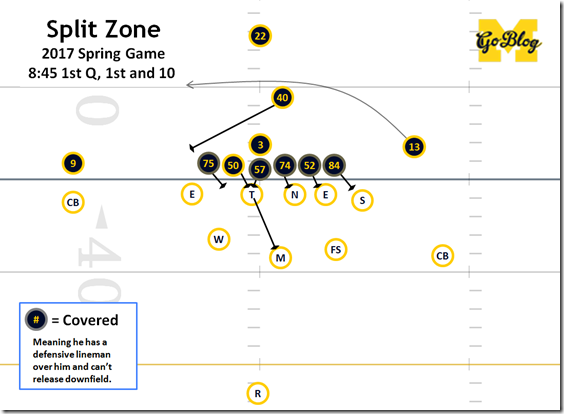
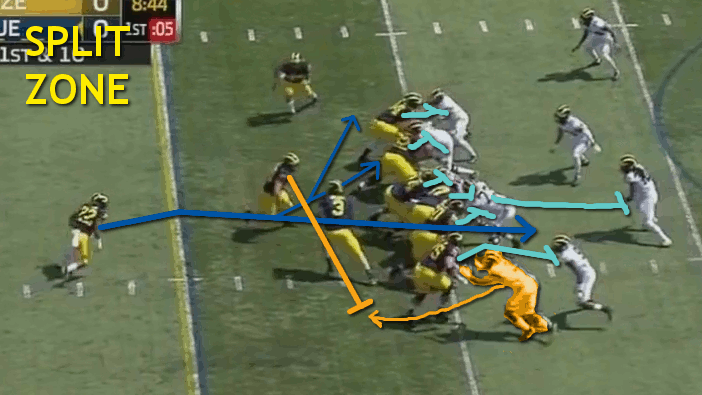
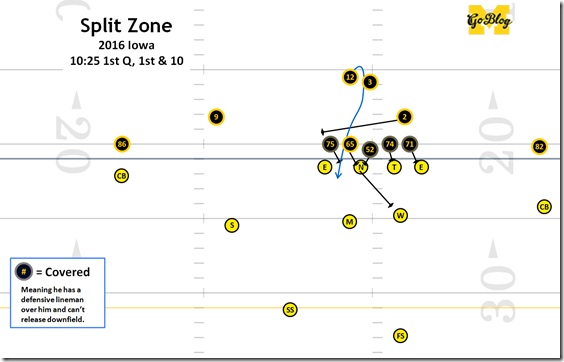
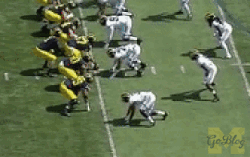
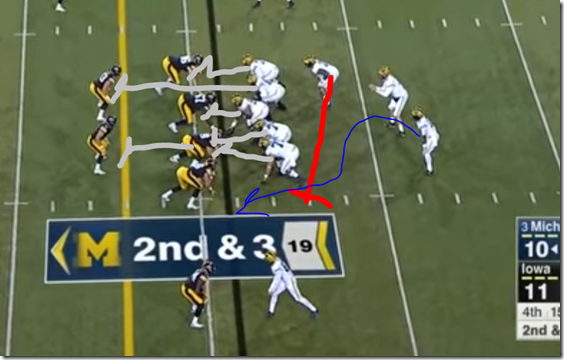
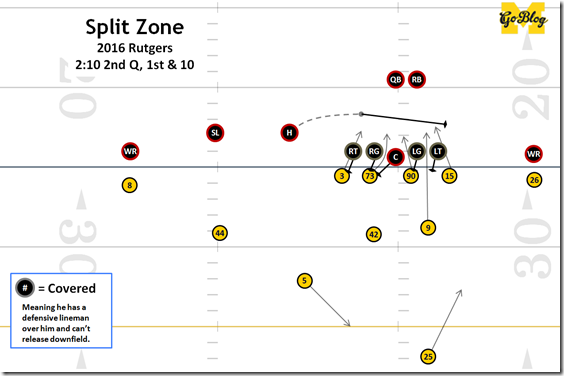
Comments